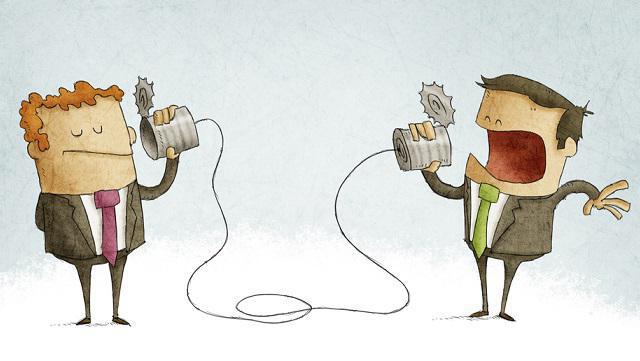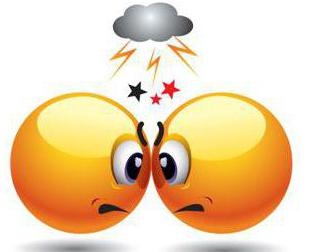Conflicts arise due to the mismatch in the cooperation or family of various emotional states, methods of action, motives and needs.

Through conflicts, a person works through many problems - either personal or industrial. Therefore, it is impossible to evaluate the conflict as a clearly negative phenomenon.
Constructive and destructive conflicts: characteristics
A timely resolved conflict significantly improves mutual understanding, and it is called constructive. A long, constantly growing confrontation, which threatens to break all forms of communication, refers precisely to negative phenomena. Such situations cannot be allowed either in the family or in the work collective. But how to do that?
In many ways, conflict situations heal relations in a group and strengthen relations. From time to time in any team even a "debriefing" is necessary. Especially if it is a company where, in order to achieve a common result, the motives and goals of disparate departments must be taken into account.

A qualified manager can manage conflicts, without control and proper leadership, no company will achieve success or a strong position in the market.
Destructive conflict arises when one of the participants crosses the social boundaries of what is permitted or intentionally aggravates an already acute situation.
The characteristics of a destructive conflict are:
- all participants have mutually exclusive goals; finding a common denominator is extremely difficult;
- the parties make efforts to stir up contradictions, and not to solve them;
- there is no regulation, no one is puzzled by the search for regulatory principles of behavior in a given situation.
These are the main features by which a constructive dispute is distinguished from a destructive one. The third point is considered the most important. Because in the constructive there is always a third party - arbitration, which is designed to build relationships.
Constructive and destructive functions of the conflict
So, what are the positive functions of the mismatch situations in industrial conflictology?
- Team building. Having learned to value their work team, people are in no hurry to find another place. There is no staff turnover in production.
- Each participant begins to understand more the motives of the other and in the future learns to be guided not only by his own, but also by common goals. So, the staff more efficiently solves all problems.
- Discharge of tension. In a busy team, not one of the participants enjoys their work.
- Stimulus to development. Each member of the team learns in the process of resolving the conflict to find a balance between personal and public interests, which will undoubtedly be useful in later life.
- Subordinates get rid of the so-called submission syndrome. It’s easier for them to express their opinions, and people don’t feel like “pawns”.

The destructive functions of the conflict are as follows:
- Decreased motivation to work. Excessive and prolonged emotional stress of participants, which can lead to neurotization of workers.
- Decrease in discipline. When the relationship clarifies, the workflow stops.
- Deteriorating emotional climate. It is very difficult to establish normal working relationships again.
- One or more employees may quit.
It is difficult to single out only the positive sides in the tense confrontation. Usually, one conflict has both positive and negative significance for its participants. After all, both of them have to compromise and lose something in the process of establishing relations.
The development of a destructive conflict situation: stages
For both sides, the development of a destructive conflict is undesirable. Therefore, we will find out the mechanism of its development, so that everyone knows how to avoid such incidents.
How does this conflict develop? There are several stages that smoothly pass one into another, by which we can characterize the degree of neglect of the collision.
- The emergence of a situation where the interests of the parties are in opposition to each other.
- Awareness of the conflict.
- Development. At this stage, a hidden confrontation can go into open. Supporters may also be involved.
- Expansion of the conflict. The increase in negative statements addressed to the other side.
- The end of the conflict.

The mechanism for the development of constructive conflict is similar. Only in it the parties always come to a mutual agreement as a result of the dispute. At the same time, both opponents change their attitudes and values.
A positive conflict goes without an expansion stage. It is resolved in most cases thanks to calm negotiations.
But in the event of a destructive conflict, one of the parties is defeated as a result and can accumulate strength for further confrontation in the name of "revenge."
Signs of escalating conflict
With the escalation of the conflict, the atmosphere is so heated that the parties, in principle, cannot see any positive qualities on the other side.
In such a conflict of interests, everyone considers the enemy an enemy. Naturally, distrust arises, as well as the desire to blame the enemy for all the failures. All participants of the opposing side are removed from among those who deserve ordinary human sympathy and participation.

These factors negatively affect the psychological state of the warring parties. As well as signs are considered the generalization of the conflict, attracting new participants to your side and the use of violence when other methods of influence are not enough.
Types of Conflict Behavior
What patterns of conflict behavior exist? There is a constructive model, destructive and conformist.
Destructive behavior in conflict is noted
- the desire to expand the conflict, to attract new participants;
- humiliation of the personality of another (as a method of influence);
- violation of communication ethics;
- intimidation of the opponent;
- focusing on one's own position, authority;
- using flattery and fawning.
The latter always shows passivity in the dispute and agrees with all requirements, even contrary to their own values. This model is also not considered constructive, because when a person gives up his own position, responsibility for himself, he unintentionally becomes a cause of conflict.
Accentuation of character and type of behavior in conflict
In adolescence and youth, some distinctive character traits become pronounced. Then these characteristics (accentuations) leave an imprint on a person’s entire life, on the way he interacts with others and on productive activities.
Accentuations are closely related to human behavior in a conflict situation. Typically, types with a brighter emotionality and desire for communication, dominance behave more aggressively in a dispute, show rivalry. These are excitable, exalted and hyperthymic types of accentuation.

Cycloid types often compromise with an opponent. But adaptation and avoidance are mainly chosen by emotive individuals. Since their functions are to protect public peace and be responsive to the problems of others.
Conflict Resolution Strategies
There are several types of strategies in conflict resolution. And depending on what strategy the opponents chose and how they showed themselves in the dispute, constructive and destructive conflict resolution is distinguished. In both cases, the conflict is settled.But a mutual solution as such in the case of its destructive completion was not found or there were not even attempts to search for it, since one of the parties simply “broke” the opponent.
According to the strategy developed by Kenneth W. Thomas, there are only five ways to find a solution:
- avoidance;
- device;
- competition;
- compromise;
- cooperation.
Collaboration and compromise are the most successful strategies that allow further active development of all parties to the dispute. And avoidance and adaptation is rather an aggravation of confrontation than a resolution of the issue.
The destructive consequences of the conflict
Uncontrolled conflict threatens both sides with a negative scenario for the development of relations in the future. If this is a conflict between 2 personalities, for example between a husband and a wife, then over time it leads to a depressed state and disorganization of the behavior of each of them. A depressed person gets tired faster and worse copes with everyday duties, which leads to an aggravation of the conflict, and then the termination of any relationship.

If we talk about the enterprise, there are several more extremely negative consequences. This is the loss of interest of employees in the direct production process, the inability to cooperate and the dismissal.
How to resolve a long conflict?
Prolonged intense confrontations between groups completely destroy the relationship. All members of another group are considered enemies. This was confirmed by an experiment conducted in the early 1950s by a group of sociologists led by M. Sheriff. The artificially created conflict between the two camps of boys aged 9-12 years continued even after emotional discharge (they were allowed to swear). The only way to reconcile the guys was general occupational therapy. General activity is the only method of all tested by specialists, which helped to restore friendly relations between groups.
Social conflicts - constructive and destructive - are equally resolved on the restoration of mutual respect and trust. And this is possible precisely in labor activity.